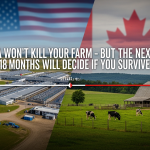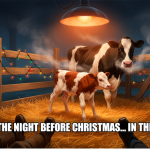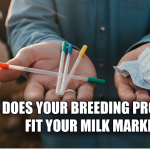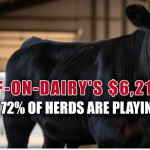Dairy Dispatch
CUSMA Won’t Kill Your Farm – But the Next 18 Months Will Decide If You Survive
The upcoming trade review isn't just policy noise—it's a deadline that's separating dairy operations positioned for the future from those still hoping […]Stop Tightening Your Belt: Dairy’s $6.35/cwt Gap and Your 90-Day Window to Close It
90 days to reposition before 2026 hits. The top 25% of dairy operations already moved. This is the playbook they're using. EXECUTIVE SUMMARY: Tig […]6 Months. 113 Outbreaks. Farmers vs. Riot Police. France’s Lumpy Skin Disease Crisis Is Writing North America’s Playbook in Real Time
Military helicopters dropping vaccines. Farmers in riot gear standoffs with police. A disease that jumped 300 kilometers in weeks despite aggressive c […]The Heifer Crisis Hiding in Plain Sight: Why Your Next 90 Days Determine Your 2028 Herd
Here's what USDA's numbers aren't saying: we're producing 2% more milk by keeping older cows longer, not breeding better replacements. Heifer inventor […]China’s 42.7% Dairy Tariff Hits the EU – Why Your Milk Check Won’t See the Boost You’re Expecting
China's 42.7% EU dairy tariff? Don't celebrate yet. NZ ships duty-free with 51% market share—and China built their herd with genetics we sold them. Ex […]
Top News Posts from Past Week
- When Christmas Magic Happens at 4 A.M.: The Vermont Dairy Farmer Who Turned a Midnight Calving into a Children’s Classic While the world sleeps on Christmas Eve, farmers walk to the barn. One dairyman turned that walk into a children's book. There is a specific kind of silence that only…
- Blondin Goldwyn Subliminal EX-97: A Final Bow for the Queen The Holstein breed says goodbye to an irreplaceable icon whose influence will echo through genetics and show rings for decades. There are great cows. There are legendary cows. And then,…
- The Mercosur Reckoning: 10,000 Farmers in Brussels Just Changed the Global Dairy Conversation When thousands of farmers from across Europe shut down the EU capital, they weren't just protesting a trade deal. They were raising questions that dairy producers on both sides of…
- 28p vs. £300 Million: The 2025 Milk Price Gap Nobody’s Explaining Asked Arla and Müller how £300M in expansions aligns with 28p milk. No response. Their annual reports answered anyway: €401M profit, margins tripled. EXECUTIVE SUMMARY: Lakeland's November 2025 price of 28.8p…
- 6 Months. 113 Outbreaks. Farmers vs. Riot Police. France’s Lumpy Skin Disease Crisis Is Writing North America’s Playbook in Real Time Military helicopters dropping vaccines. Farmers in riot gear standoffs with police. A disease that jumped 300 kilometers in weeks despite aggressive containment. France's lumpy skin disease crisis is writing the…
More News
- The $97,500 Protein Shift: How Weight-Loss Drug Users Are Rewriting Your Breeding Strategy
- 28p vs. £300 Million: The 2025 Milk Price Gap Nobody’s Explaining
- The 90-Day Reckoning: What Your Milk Check Is Really Saying About 2026
- 40% Muscle Loss in 60 Days: The Genetic Time Bomb Hiding in Your Fresh Pen
- Biology Repriced Dairy: $4,000 Heifers Created a 90-Day Window When You Have Leverage, Not Processors
Feature Articles
‘Twas the Night Before Christmas… in the Freestall Barn
While social media influencers are asleep right now. You're standing in a frozen barn at midnight, holding a flashlight, beca […]Does Your Breeding Program Fit Your Milk Market?
The same genetics cost one farm $190,000/year and make another farm $57,000. The difference? Market alignment. E447 Does Your […]The Room Went Quiet. Everyone Left. Then an $8,100 Phone Call Changed Holstein History Forever.
The untold stories of Rudy Missy, Blackrose, and the stockmen who saw what the experts couldn't E446 The Room Went Quiet. Eve […]Beef-on-Dairy’s $6,215 Secret: Why 72% of Herds Are Playing It Wrong
64-year low in beef cows. $1,100 dairy-cross calves. 2.5 million replacement heifers. Do the math. E445 Beef-on-Dairy’s $6,21 […]Zero Mastitis Tubes Since March: The Protocol Change That’s Emptying Hospital Pens
Your antibiotics aren't failing. The bacteria are hiding—in fortresses 1,000x stronger than the treatment you're using. Here' […]
Popular Articles from the Past 30 Days
- They Called Him the Three-Legged Bull. He Created the Modern Red Holstein: The Untold Story of Hanover-Hill Triple Threat-Red 53 years ago, a man bet his career on a red calf everyone else called a defect. He was right E433 They Called Him the Three-Legged Bull. He Cre |…
- Four Bets. Five Legends: The Holstein Visionaries Who Built Everything You’re Breeding Today Four breeders made four impossible bets. Every Holstein alive today is the payoff. Here's what they knew that we forgot. E340 Four Bets. Five Legends: The Holstein Vision | RSS.com…
- The Room Went Quiet. Everyone Left. Then an $8,100 Phone Call Changed Holstein History Forever. The untold stories of Rudy Missy, Blackrose, and the stockmen who saw what the experts couldn't E446 The Room Went Quiet. Everyone Left. Then an $ | RSS.com It was…
- Trembling Hands, A Decade of Faith, 200 Fewer Cows: Three Paths to the Same Truth Trembling hands at Expo. A decade of faith. 200 fewer cows. Three families. One truth about what excellence really costs. E443 Trembling Hands, A Decade of Faith, 200 Fewer |…
- ‘Twas the Night Before Christmas… in the Freestall Barn While social media influencers are asleep right now. You're standing in a frozen barn at midnight, holding a flashlight, because cows don't do Christmas. ‘Twas the Night Before Christmas… in…
More Articles
- Trembling Hands, A Decade of Faith, 200 Fewer Cows: Three Paths to the Same Truth
- She Won’t Win Shows, But She Pays the Bills: The Rise of the $3,000 ‘System Cow.’
- The 18-Month Window: Why Your Lender Knows Your Dairy’s in Trouble Before You Do
- Four Bets. Five Legends: The Holstein Visionaries Who Built Everything You’re Breeding Today
- 2025 Dairy Year in Review: Ten Forces That Redefined Who’s Positioned to Thrive Through 2028
The Bullvine LLC © 2025 | Terms of Use | Community Guidelines | Privacy Policy |
Functional Always active
Preferences
Statistics
Marketing
To provide the best experiences, we and our partners use technologies like cookies to store and/or access device information. Consenting to these technologies will allow us and our partners to process personal data such as browsing behavior or unique IDs on this site and show (non-) personalized ads. Not consenting or withdrawing consent, may adversely affect certain features and functions.
Click below to consent to the above or make granular choices. Your choices will be applied to this site only. You can change your settings at any time, including withdrawing your consent, by using the toggles on the Cookie Policy, or by clicking on the manage consent button at the bottom of the screen.
















